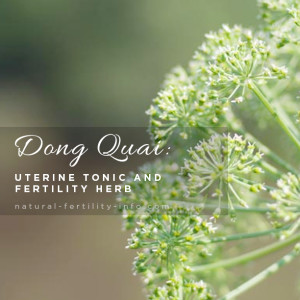 Question: Please advise if I should use Fertilica Dong Quai if I have a uterine myoma (small one). I am 25 y.o. now and planning to conceive within several months. I thought Dong Quai is not suggested for myoma…
Question: Please advise if I should use Fertilica Dong Quai if I have a uterine myoma (small one). I am 25 y.o. now and planning to conceive within several months. I thought Dong Quai is not suggested for myoma…
Answer: Fertilica Dong Quai contains Dong Quai root (Angelica sinensis) which can be a useful herb for most women with myomas, more commonly called uterine fibroids or polyps. However, it may not be the right choice for every woman with uterine fibroids. In order to suggest Dong Quai, an herbalist would first talk with you about your reproductive health history.
Your personal experiences with how the uterine fibroids are affecting your health is important when considering any herbal protocol.
That being said, in an effort to help you learn if Dong Quai is right for you, let me share more information about this female fertility tonic herb and why it may be helpful for uterine fibroids…
Dong Quai is known to indirectly influence the regulation of hormone production by mildly stimulating liver cleansing (the liver metabolizes hormones and helps to remove excess hormones in the body). It in part strengthens the uterus and nourishes the blood to improve red blood cell counts (needed in cases of anemia).
Dong Quai is also known as an anti-inflammatory herb that is analgesic (pain relieving) and antispasmodic. It is traditionally used for fertility health issues caused by blood stagnation, which uterine fibroids are in part a result of. Known to relax and stimulate uterine, vascular, and intestinal smooth muscle, Dong Quai may be useful in relieving pelvic congestion causing pain and discomfort. It does so by increasing circulation (blood flow) to the uterus.
A common rumor going around about Dong Quai is that it increases estrogen levels in the body. Because uterine fibroids are associated with estrogen dominance, it would seem best to avoid anything that may be “estrogenic”, but it isn’t that cut and dried…
Clinical studies are inconclusive and have not yet proven that Dong Quai has estrogenic effects in humans — although it does, like many plants, contain phytoestrogens. Phytoestrogens have a similar, yet much weaker, estrogen-like effect in the body. Phytoestrogens have the ability to bind to estrogen receptor sites, which actually helps to protect the body from much stronger environmental estrogens known as xenoestrogens. Examples of xenoestrogens: pesticides, house paint, food dyes, plastics.
Most natural healthcare practitioners agree that phytoestrogens impact estrogen-dominant fertility health conditions, like uterine fibroids, in a positive way. This is because phytoestrogens may offer the body protection from xenoestrogens, which contribute to estrogen dominance. As the “gynecological regulator” of herbs, Dong Quai may have the ability to lower high estrogen levels and conversely raise low estrogen levels – meeting the needs of the body versus causing an estrogen imbalance.
While this potent female fertility health herb, regarded as a fertility promoter, can be rather fast-acting and effective for many fertility health issues, we feel various other herbs, nutritional supplements, and natural therapies are worth considering as well. Consider natural therapies that are known to support the body in:
- maintaining a healthy environment within the uterus
- its natural ability to reduce occurrences of occasional growths
- balancing hormones to achieve healthy estrogen levels by eliminating exogenous sources of estrogen (from diet and lifestyle)
- metabolizing excess estrogen
The article The Best Natural Remedies for Uterine Fibroids offers ways support the body in doing all of the aspects mentioned above.
If interested in trying Dong Quai, for general suggested use guidelines visit Dong Quai: Uterine Tonic and Fertility Herb… and consider learning the 7 Little-Known Fertility Benefits of Dong Quai.
Dong Quai is not to be used during menstruation, in pregnancy or while breastfeeding, and not along with anticoagulant drugs, such as blood thinners, or hormonal medications.
- Gladstar, R. (1993). Materia Medica For Women. In Herbal Healing for Women (pp. 240-241). New York. Simon & Schuster.
- Romm, A. (2010). Plant Profiles. In Botanical medicine for women’s health (pp. 534-535). St. Louis, Missouri: Churchill Livingstone/Elsevier





